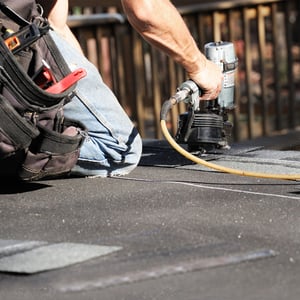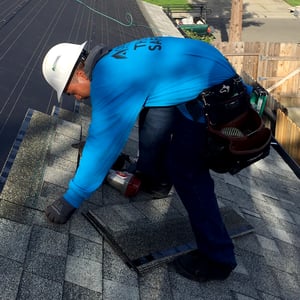Many homeowners (and business owners) are fully prepared to install new roofs in conjunction with their solar projects, because they need to or want to. Others wonder, Should I replace my roof before going solar? Do I have to?
Here are the top two reasons to consider installing a solar energy system and a new roof together at your home:
- If you’re putting a new roof on your property, it makes sense to add a solar energy system at the same time because the solar savings on your electric bills help pay for the roof.
- Both products last for decades so installing them together “aligns the life cycles” ensuring worry-free performance from both the solar and the roof for years to come.
But installing both products together doesn’t make sense for everyone. Let us run you through various scenarios to help you make your decision. We also provide tips for evaluating your roof's condition.
Typical Scenarios for Solar & Roofing
At Citadel Roofing & Solar, we’ve installed thousands of solar energy systems and tens of thousands of roofs throughout California. We often do both projects together. Our customers generally fall into three categories of wants and needs:
- They come to us for new roofs and decide to add solar to their projects.
- They come to us for solar and their house (and thus their roof) is less than 15 years old; in virtually all these cases, a new roof is not needed. However, roofs age differently based on weather and quality so this is not an iron-clad rule.
- They come to us for solar on an older home; in roughly 35 percent of these cases, we find a new roof is recommended and installed. However, the majority of the roofs on older homes are absolutely fine and have 15+ years of life in them. It’s interesting that a significant number of the people who don’t need a new roof choose to install one at the same time as their solar anyway.
Reasons to Install a New Roof and Solar Together
Here, in more detail, are the benefits of re-roofing and going solar at the same time.
- The electricity savings from the solar help pay for the new roof. It’s like getting a new roof courtesy of the sun. How is this possible? As solar owners know, the electricity savings you get from using your own solar electricity instead of the utility’s more expensive electricity add up over time. Eventually those savings equal more than what you spent on the solar, and—since the savings continue after that—they can also pay back what you spent for the new roof.
- Consolidating a new roof and a solar energy system into one home improvement project makes the process easier.
- One home improvement contractor to deal with
- One project timeline
- One contact for scheduling the work
- One company providing your warranties
- Both products last for decades. Today’s long-lasting roof materials come with warranties that often last from 30 years to “lifetime”. Many solar panels are warrantied for 25 years. So while it’s not mandatory to align the “life cycles” of your home’s systems, it does make sense. Think of it like a car: If your old vehicle has maybe 20,000 miles left in it and needs new tires, you’re probably not going to buy tires warrantied for 50,000 miles. Similarly, we don’t recommend putting 25-year solar panels on a roof with, say, seven or eight years left in it.

- You won’t have to uninstall and reinstall your solar. Homeowners who put solar energy systems on roofs that have less than 15 years of life in them usually end up calling a solar installer like Citadel Roofing & Solar to remove the solar system so the roof can be replaced. Then, of course, the solar system has to be reinstalled. It can be done—Citadel does this weekly—but it takes time and money—your time and money.
- You can streamline your financing with one loan for both products. Generally speaking, you can finance solar and a new roof together through solar loans, home improvement and home equity loans and other bank loans. That means one application instead of two, and one monthly payment instead of two.
Reasons to Install a New Roof Without Solar
The truth is, there are no good reasons to install a new roof without solar, unless your roof truly does not work for solar—maybe it’s in the woods with no sunlight whatsoever reaching it.
Most people come to us prepared to redo their roof in conjunction with installing solar. Others have questions about the additional cost. But when our experts explain that the electric bill savings from the solar eventually cover the cost of the roof, most homeowners agree it makes absolute sense to bundle the two projects together. 
Consider this extremely simplified analogy: You can spend $10 and get nothing back. Or you can spend $20 and get $2.50 back per year. Eventually you’ll not only be paid back for the additional $10 you spent, you’ll be paid back for the original $10 you spent too. That’s how solar pays for itself and your new roof.
Reasons to Install Solar Without a New Roof
As long as your roof can support the weight of a solar energy system, and it has a significant number of years of life left in it, there is no need to install a new roof at the same time that you install a solar energy system.
Where things get tricky is when shady installers don’t advise homeowners that they need a new roof. Installing a shiny new solar energy system on an aging or compromised roof usually results in the homeowner eventually having the solar panels and wiring removed temporarily while a new roof is installed, and then having the solar equipment re-installed.
Citadel does this type of project weekly for people given bad advice by their solar installer. Those installers only cared about getting the solar up and being paid. But it’s you—the homeowner—who pays the price, literally, when the solar needs to come down so the roof can be repaired or replaced.
That’s why the homeowners who choose to install solar but not a new roof generally live in new homes, or a home with a relatively new roof. Those whose roofs have less than 15 years of viable life left typically re-roof in conjunction with their solar installation projects or wait to get solar until they are ready to replace their roof.
If you’re not sure how old your roof is, jump ahead for tips on assessing its condition.
Why People Replace Their Roof When They Don’t Have To
Interestingly, even if Citadel’s assessment of the roof suggests it does not need to be replaced before installing solar, some people choose to re-roof anyway, for one of two reasons:
- They are remodeling, renovating or painting the house and want a different color or material roof as part of the new aesthetic for their home.
- They know their solar will perform for decades and they want the roof supporting the solar to be equally long-lasting.
If you have the original paperwork on your current roof’s installation, you can check its expected life against its current age to determine how many more years it should last. But be aware that, much like car tires, wear and tear on two exact roofs can vary greatly if they’re in different locations with different regional weather conditions. For example, one might have tree branches nearby that can brush against the shingles or even land on the roof, or it might be exposed to more sun, wind, rain and snow, all of which beat on your roof and can compromise its integrity over time.
Visual inspection is the ultimate way to determine your roof’s condition. But we do not recommend you climb a ladder for a close inspection of your roof material! Too many accidents occur when homeowners get on their roofs. Please call a roofing professional like Citadel for an inspection.
Having said that, you may be able to spot some signs of damage or wear and tear from safe locations like the ground or a second-story window, depending on your roof’s height and configuration.
These issues clearly suggest your roof needs repair or replacement:
- Cracked, broken or loose tiles
- Broken, loose or curling shingles
- Buckling, warping or pooling water on a flat roof
Further, if you spot any of these related problems, your roof may be affected and need replacement or repair:
- Tree debris accumulating on the roof
- Tree limbs resting on the roof (of most concern on a membrane roof)
- Wood rot in the eaves or overhangs
- Gutters that don’t work properly
More Resources
While most homeowners come to us prepared to invest in a new roof and solar at the same time, because they see it as a logical way to protect their largest single asset—their home—others have questions, which is understandable. Contact us today for answers to your questions about installing solar and/or roofing.
For more information on roofing and solar, visit our Learn/Roofing page or one of these blog posts:
- Residential Roofing 101
- How Roof and Solar Warranties Impact Each Other
- Understanding Common Solar Installation Problems


